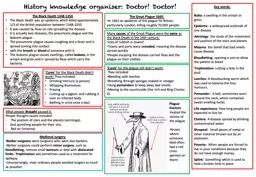

Doctor Doctor Key words Bubo a swelling in the armpit or groin Epidemic a widespread outbreak of one disease Astrology the study of the movement and position of the stars and planets ID: 926989
Download Presentation The PPT/PDF document "History knowledge organiser" is the property of its rightful owner. Permission is granted to download and print the materials on this web site for personal, non-commercial use only, and to display it on your personal computer provided you do not modify the materials and that you retain all copyright notices contained in the materials. By downloading content from our website, you accept the terms of this agreement.
Slide1
History knowledge organiser: Doctor! Doctor!
Key words:Bubo: a swelling in the armpit or groin.Epidemic: a widespread outbreak of one diseaseAstrology: the study of the movement and position of the stars and planetsMiasma: the belief that bad smells cause disease.Bloodletting: opening a vein to allow the patient to bleedTrephination: cutting a hole in the skullLeeches: A bloodsucking worm which was used to balance the four humours. Pomander: A ball, sometimes worn around the neck, which contained sweet smelling herbs. Life expectancy: How long people are expected to live for. Cholera: A disease spread by drinking contaminated waterShrapnel: Small pieces of metal or other material thrown out by an explosion. Poverty: When people are forced to live in poor conditions because they do not have enough money. Splint: Something which is used to hold a broken limb in place.
The Black Death 1348-1350
The Black Death was an epidemic which killed approximately 1/3 of the British population between 1348-1350.It was caused by fleas on rats spreading the disease. It is actually two diseases, the pneumonic plague and the bubonic plague.The pneumonic plague causes coughing and a fever and is spread coming into contact with the breath or blood of someone with it. The bubonic plague causes swellings, called buboes, in the armpit and groin and is spread by fleas which carry the bacteria.
‘Cures’ for the Black Death didn’t work! They included: Drinking mercury (a poison)Whipping themselvesPraying Cutting up a pigeon and rubbing it over an infected body. Bathing in urine once a day!
What people thought caused it: People thought causes included: The position of stars and the planets (astrology). God punishing people for their sins. Bad air (miasma)
Medieval surgeryBarber surgeons were surgeons who were also barbers.Barber surgeons could perform minor surgery, such as bloodletting, remove small tumours or deal with dislocated limbs. Trephination was sometimes used as a treatment for epilepsy. Unsurprisingly, most ordinary people avoided surgery as much as possible!
The Great Plague 1665: In 1665 an epidemic of the plague hit Britain, particularly London, killing roughly 70,000 people.
Many causes of the Great Plague were the same as the Black Death in the 14th century: Lots of rubbish in towns! Towns and ports were crowded, meaning the disease spread quickly. People escaping the disease carried fleas and the plague on their clothes.
‘Cures’ for the plague still didn’t work! They included: Bleeding with leeches Breathing through sponges soaked in vinegar. Using pomanders to keep away bad smells. Moving to the countryside (the rich and King Charles II).
Plague Doctors
treated the victims of the plague.Houses where someone died often had a red cross painted on them!
Slide21854 Broad Street cholera outbreakIn
1854 a major outbreak of cholera occurred in Broad Street in London. The local doctor, John Snow, investigated the cause and proved that cholera was spread by water rather than by ‘bad smells’. This discovery helped to improve how clean the streets were and make sure sewage systems worked properly. 19th Century Health and Medicine (1800-1899)During the 19th century public health
in towns and cities was very bad because of poor housing, overcrowding and sewage and rubbish filling the streets.Life expectancy
in Britain was low: in 1840 the average life expectancy in Britain was 40! The Great Stink 1858In 1858 a heat wave revealed tonnes of rotting waste in the Thames. The smell was so bad that MPs in the Houses of Parliament tried soaking their curtains in chlorine to cover it!Eventually, a new sewer system was built which improved public health.
The Impact of World War One on medicine: Between 1914 and 1918 most of the countries in Europe were involved in World War One. Over this period new weapons, such as mustard gas and grenades were developed, causing new injuries and conditions in the trenches also made infection extremely common.
Injured and sick soldiers needed to be treated quickly so they could go back to fighting as soon as possible.Medical improvements:X-ray technology helped surgeons to detect where a bullet had hit. Many operations were performed during the war thanks to this.Blood was first stored successfully during World War One. Doctors could now give blood transfusions to soldiers. Before, soldiers with burns and diseases would have usually died.
The army leg splint was developed, which held broken bones in place while they healed. Harold Gillies (an army surgeon) worked with injured soldiers to develop techniques for plastic surgery. Science
Different materials are used for particular jobs based on their properties: electrical conductivity, flexibility, hardness, insulators, magnetism, solubility, thermal
conductivity, transparency. What materials would be good in a hospital?